The Dental Radiometer Market is estimated to be valued at USD 170.1 million in 2025 and is projected to reach USD 319.4 million by 2035, registering a compound annual growth rate (CAGR) of 6.5% over the forecast period.
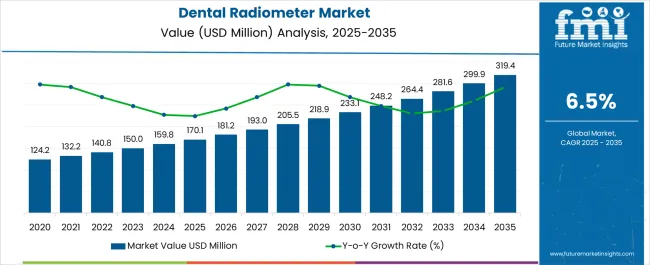
| Metric | Value |
|---|---|
| Dental Radiometer Market Estimated Value in (2025 E) | USD 170.1 million |
| Dental Radiometer Market Forecast Value in (2035 F) | USD 319.4 million |
| Forecast CAGR (2025 to 2035) | 6.5% |
The Dental Radiometer market is experiencing steady growth, driven by increasing demand for precise light measurement in dental curing procedures and the rising adoption of advanced dental technologies. Growing awareness of the importance of correct curing light intensity to ensure optimal polymerization of dental materials has fueled adoption across clinics and hospitals. Technological advancements in light-emitting diode systems, combined with improved sensor accuracy and compact design, have enhanced the usability and reliability of dental radiometers.
Integration of digital readouts and calibration features has further supported operational efficiency and procedural consistency. The increasing prevalence of cosmetic dentistry procedures, rising investments in dental infrastructure, and the adoption of minimally invasive restorative techniques have contributed to market expansion.
Regulatory guidelines emphasizing the importance of quality control in dental treatments are further supporting the use of radiometers As dental clinics and hospitals prioritize precision, patient safety, and treatment effectiveness, the market is expected to maintain sustained growth, with continued innovations in sensor technology and device portability creating new opportunities for adoption in clinical practices worldwide.
The dental radiometer market is segmented by product type, application, end user, and geographic regions. By product type, dental radiometer market is divided into LED (Light Emitting Diodes) Radiometer, QTH (Quartz-Tungsten-Halogen) Radiometer, and Bluephase Radiometer. In terms of application, dental radiometer market is classified into Direct Composite Restoration, Indirect Ceramic Restoration, Curing Of Adhesive Cements, and Others. Based on end user, dental radiometer market is segmented into Dental Clinics and Hospitals. Regionally, the dental radiometer industry is classified into North America, Latin America, Western Europe, Eastern Europe, Balkan & Baltic Countries, Russia & Belarus, Central Asia, East Asia, South Asia & Pacific, and the Middle East & Africa.
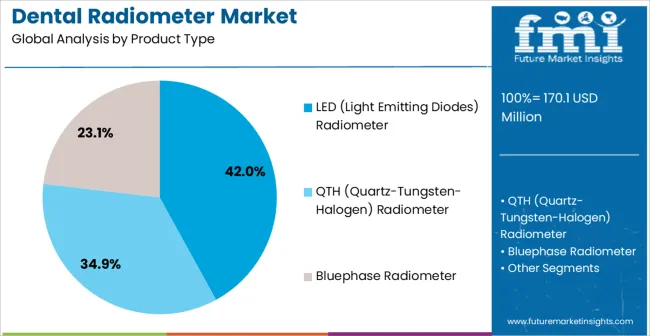
The LED Light Emitting Diodes radiometer segment is projected to hold 42.0% of the market revenue in 2025, establishing it as the leading product type. Growth in this segment is driven by the increasing use of LED-based dental curing lights, which require precise measurement of light intensity to ensure optimal polymerization of restorative materials. LEDs provide consistent output, energy efficiency, and longer lifespan compared to traditional light sources, making radiometers compatible with these devices highly desirable.
The ability to deliver accurate, real-time readings supports improved clinical outcomes and procedural reliability. Compact design, portability, and user-friendly interfaces further enhance adoption in dental practices of all sizes.
Technological advancements in sensor accuracy, digital display integration, and automatic calibration have strengthened the reliability of LED radiometers Rising adoption of LED curing devices in preventive, restorative, and cosmetic dentistry procedures ensures that this segment will maintain its market leadership, supported by clinical demand for precision, safety, and operational efficiency in dental treatments.
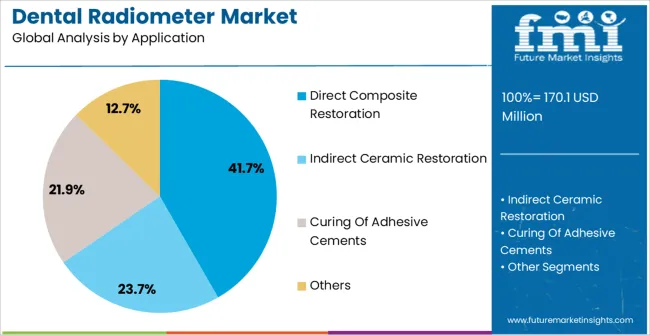
The direct composite restoration application segment is expected to account for 41.7% of the market revenue in 2025, making it the leading application area. Growth is being driven by the increasing preference for minimally invasive and esthetically appealing restorative dental procedures, which rely on precise curing of composite resins. Dental radiometers play a critical role in ensuring that adequate light intensity is delivered, minimizing the risk of incomplete polymerization and post-treatment failures.
The integration of accurate measurement tools improves clinical outcomes, reduces procedure time, and enhances patient satisfaction. Rising adoption of composite restorations in both permanent and temporary treatments is supporting demand for reliable radiometers.
Technological enhancements such as digital readouts, ergonomic designs, and compatibility with a range of LED curing devices are further strengthening adoption As cosmetic and restorative dental procedures continue to increase globally, the direct composite restoration segment is expected to remain a primary driver of market growth, supported by rising focus on treatment precision, material performance, and operational efficiency.
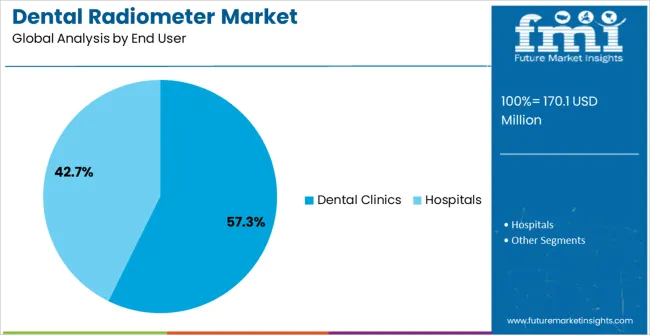
The dental clinics end user segment is projected to hold 57.3% of the market revenue in 2025, establishing it as the largest end-user category. Growth in this segment is driven by the increasing number of dental clinics and their focus on delivering high-quality, reliable, and efficient treatments. Dental radiometers are being widely adopted in clinics to monitor light intensity for curing procedures, ensuring consistent polymerization of restorative materials and minimizing procedural errors.
Clinics benefit from portable, easy-to-use devices that integrate seamlessly into routine workflows. Rising awareness among practitioners about the importance of curing light monitoring and regulatory emphasis on quality control is further accelerating adoption.
The segment is also supported by investments in advanced dental equipment, growing patient demand for cosmetic and restorative procedures, and the preference for minimally invasive treatments As clinics continue to expand and upgrade their technology infrastructure, reliance on LED radiometers is expected to remain high, reinforcing this segment as the leading end user in the market.
Dental radiometer, commonly is a simplified and less accurate laboratory equipment, used exclusively by the dentists to measure light output. Dental radiometers often provide dentists with a general benchmark but do not allow accurate measurement of amount of curing light. Also, dental radiometers are not wise tools to compare different types of light and their performance.
This is due to the ability of the detector present in a radiometer to detect only a portion of the output from curing light. Owing to the non-uniform nature of the output from curing lights, the light intensity varies significantly depending upon the portion tested. As the detector present in radiometer is not equally responsive to different wavelengths of light, dental radiometers show less sensitivity to some wavelengths of light over others.
Dental Radiometer are available in a wide range of wavelengths and offer high advantage over conventional radiometers. The main components of a dental radiometer includes the case, diffusers, filters, detectors, display. The readings on display may show a deflection of ±20% from the actual value. On the basis of product type, dental radiometer market is broadly categorized into three types including light emitting diodes (LED) radiometer, Quartz-Tungsten-Halogen (QTH) radiometer and Bluephase radiometer.
These radiometers are portable and simple to operate, yet offers various application that involves direct composite restoration, indirect ceramic restoration, curing of adhesive cements and others in the dental radiometer market. However, insufficient polymerization of the composites is usual reason leading to failures in placement of direct or indirect restorations.
Due to the incompletely cured restoratives, postoperative sensitivity is a common dental condition that even necessitates endodontic treatment. Hence, it is necessary to check the light strength of polymerization lights regularly, as the light power may drops over time. Bluephase radiometer with “polywave” broadband spectrum technology is capable of polymerization of light-curing dental materials in range of wavelengths 385-515 nm and forms significant component of dental radiometer market.
The rising demand for technologically advanced dental radiometer for dentists is expected to drive the revenue generation in global dental radiometer market. Some of the limiting factors hampering growth of dental radiometer market include lack of skilled manpower and technicians.
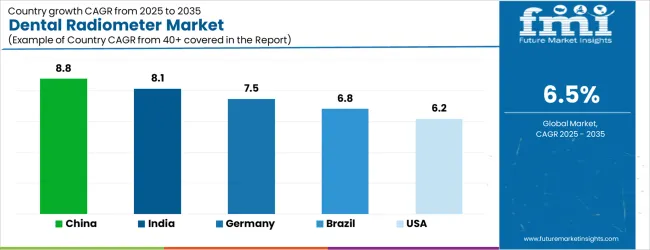
| Country | CAGR |
|---|---|
| China | 8.8% |
| India | 8.1% |
| Germany | 7.5% |
| Brazil | 6.8% |
| USA | 6.2% |
| UK | 5.5% |
| Japan | 4.9% |
The Dental Radiometer Market is expected to register a CAGR of 6.5% during the forecast period, exhibiting varied country level momentum. China leads with the highest CAGR of 8.8%, followed by India at 8.1%. Developed markets such as Germany, France, and the UK continue to expand steadily, while the USA is likely to grow at consistent rates. Japan posts the lowest CAGR at 4.9%, yet still underscores a broadly positive trajectory for the global Dental Radiometer Market. In 2024, Germany held a dominant revenue in the Western Europe market and is expected to grow with a CAGR of 7.5%. The USA Dental Radiometer Market is estimated to be valued at USD 62.3 million in 2025 and is anticipated to reach a valuation of USD 62.3 million by 2035. Sales are projected to rise at a CAGR of 0.0% over the forecast period between 2025 and 2035. While Japan and South Korea markets are estimated to be valued at USD 8.1 million and USD 5.8 million respectively in 2025.
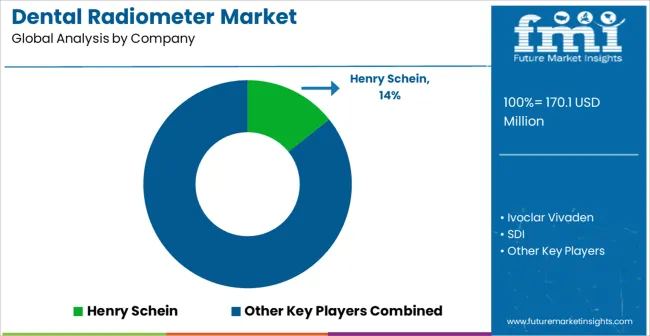
| Item | Value |
|---|---|
| Quantitative Units | USD 170.1 Million |
| Product Type | LED (Light Emitting Diodes) Radiometer, QTH (Quartz-Tungsten-Halogen) Radiometer, and Bluephase Radiometer |
| Application | Direct Composite Restoration, Indirect Ceramic Restoration, Curing Of Adhesive Cements, and Others |
| End User | Dental Clinics and Hospitals |
| Regions Covered | North America, Europe, Asia-Pacific, Latin America, Middle East & Africa |
| Country Covered | United States, Canada, Germany, France, United Kingdom, China, Japan, India, Brazil, South Africa |
| Key Companies Profiled | Henry Schein, Ivoclar Vivaden, SDI, Kerr Restoratives, Dentalget, DentAmerica, Dymax Corporation, First Medica, Practicon, Inc, Motion Dental Equipment Corporation, Pac-Dent International, Rolence Enterprise, International Light Technologies Inc, and Spring Health Products |
The global dental radiometer market is estimated to be valued at USD 170.1 million in 2025.
The market size for the dental radiometer market is projected to reach USD 319.4 million by 2035.
The dental radiometer market is expected to grow at a 6.5% CAGR between 2025 and 2035.
The key product types in dental radiometer market are LED (light emitting diodes) radiometer, qth (quartz-tungsten-halogen) radiometer and bluephase radiometer.
In terms of application, direct composite restoration segment to command 41.7% share in the dental radiometer market in 2025.






Our Research Products

The "Full Research Suite" delivers actionable market intel, deep dives on markets or technologies, so clients act faster, cut risk, and unlock growth.

The Leaderboard benchmarks and ranks top vendors, classifying them as Established Leaders, Leading Challengers, or Disruptors & Challengers.

Locates where complements amplify value and substitutes erode it, forecasting net impact by horizon

We deliver granular, decision-grade intel: market sizing, 5-year forecasts, pricing, adoption, usage, revenue, and operational KPIs—plus competitor tracking, regulation, and value chains—across 60 countries broadly.

Spot the shifts before they hit your P&L. We track inflection points, adoption curves, pricing moves, and ecosystem plays to show where demand is heading, why it is changing, and what to do next across high-growth markets and disruptive tech

Real-time reads of user behavior. We track shifting priorities, perceptions of today’s and next-gen services, and provider experience, then pace how fast tech moves from trial to adoption, blending buyer, consumer, and channel inputs with social signals (#WhySwitch, #UX).

Partner with our analyst team to build a custom report designed around your business priorities. From analysing market trends to assessing competitors or crafting bespoke datasets, we tailor insights to your needs.
Supplier Intelligence
Discovery & Profiling
Capacity & Footprint
Performance & Risk
Compliance & Governance
Commercial Readiness
Who Supplies Whom
Scorecards & Shortlists
Playbooks & Docs
Category Intelligence
Definition & Scope
Demand & Use Cases
Cost Drivers
Market Structure
Supply Chain Map
Trade & Policy
Operating Norms
Deliverables
Buyer Intelligence
Account Basics
Spend & Scope
Procurement Model
Vendor Requirements
Terms & Policies
Entry Strategy
Pain Points & Triggers
Outputs
Pricing Analysis
Benchmarks
Trends
Should-Cost
Indexation
Landed Cost
Commercial Terms
Deliverables
Brand Analysis
Positioning & Value Prop
Share & Presence
Customer Evidence
Go-to-Market
Digital & Reputation
Compliance & Trust
KPIs & Gaps
Outputs
Full Research Suite comprises of:
Market outlook & trends analysis
Interviews & case studies
Strategic recommendations
Vendor profiles & capabilities analysis
5-year forecasts
8 regions and 60+ country-level data splits
Market segment data splits
12 months of continuous data updates
DELIVERED AS:
PDF EXCEL ONLINE
Dental Repair Membranes for Implant Procedures Market Size and Share Forecast Outlook 2025 to 2035
Dental Cavity Filling Materials Market Size and Share Forecast Outlook 2025 to 2035
Dental Implant and Prosthetic Market Size and Share Forecast Outlook 2025 to 2035
Dental Imaging Equipment Market Forecast and Outlook 2025 to 2035
Dental Wounds Treatment Market Size and Share Forecast Outlook 2025 to 2035
Dental Anaesthetic Market Size and Share Forecast Outlook 2025 to 2035
Dental Diamond Bur Market Size and Share Forecast Outlook 2025 to 2035
Dental Laboratory Market Size and Share Forecast Outlook 2025 to 2035
Dental Matrix Systems Market Size and Share Forecast Outlook 2025 to 2035
Dental Permanent Cements Market Size and Share Forecast Outlook 2025 to 2035
Dental Bleaching Agent Market Size and Share Forecast Outlook 2025 to 2035
Dental Care Products Market Size and Share Forecast Outlook 2025 to 2035
Dental Etching Liquid Market Size and Share Forecast Outlook 2025 to 2035
Dental Sutures Market Analysis - Size, Share, and Forecast Outlook 2025 to 2035
Dental Hygiene Devices Market Size and Share Forecast Outlook 2025 to 2035
Dental Implantology Software Market Analysis - Size, Growth, & Forecast Outlook 2025 to 2035
Dental Veneers Market Size and Share Forecast Outlook 2025 to 2035
Dental X-Ray Systems Market Analysis - Size, Share, and Forecast Outlook 2025 to 2035
Dental Suction Systems Market Size and Share Forecast Outlook 2025 to 2035
Dental Articulators Market Size and Share Forecast Outlook 2025 to 2035

Thank you!
You will receive an email from our Business Development Manager. Please be sure to check your SPAM/JUNK folder too.
Chat With
MaRIA